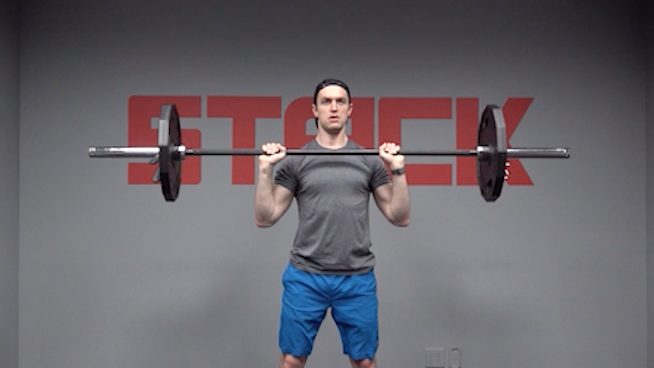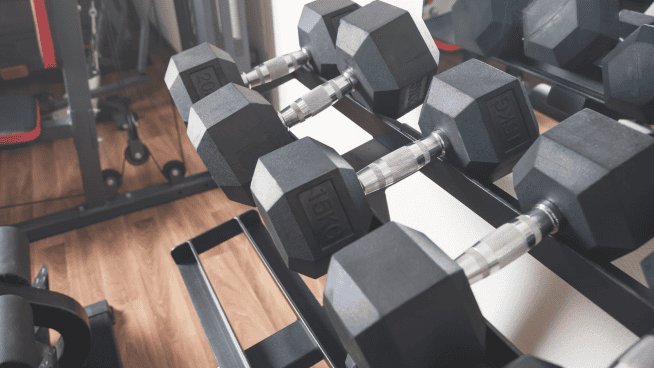How the Military Press Benefits Athletes
The Military Press will whip your upper body into shape in a hurry. This old-school exercise has been around since the advent of barbells. While it might look simple, there are a number of ways a Military Press can go wrong, some of which could cause serious injury. But when performed correctly, the Military Press offers a host of benefits.
How to Military Press
Follow these instructions to execute a proper Military Press (also shown in the video player above):
- Start by placing a barbell on a squat rack at about chest height
- Pick the barbell up and give yourself room to perform the exercise
- Your grip on the barbell should be pronated (palms facing out) and slightly wider than shoulder width. The bar rests in the middle of your hands, not on your fingers
 At the starting position, the barbell is just above your deltoids. Feet should be roughly shoulder-width apart. Elbows should be tight to your body, not pushed out in front of you.
At the starting position, the barbell is just above your deltoids. Feet should be roughly shoulder-width apart. Elbows should be tight to your body, not pushed out in front of you.- Create full-body tension by tightening your core and pushing your heels into the ground.
- Keeping your torso and lower body rigid, press the barbell toward the ceiling by extending your arms overhead.

- “Push” your hips forward a bit as you press the barbell overhead so the load is as close to your center of gravity as possible. You must do this while the barbell is passing by your head—if you do it too early, you risk bonking yourself on the barbell.
- Keep your torso and lower body tight and rigid to prevent unnecessary movement during the exercise.
- Pause for a count at the top of the exercise.

- Following the same path you used to press the bar, return it to the starting position. Allow your hips to naturally pull back a bit so as to allow the barbell to return to the starting position.
Common Mistakes of The Military Press
The most common mistake people make with the Military Press is simply using too much weight. Since it looks like such a simple movement, many people assume they’re capable of pressing more weight than they actually are. The key is finding a weight that allows you to perform 3 sets of 8 reps with strict good form and go from there.
Pressing the barbell too far in front of your body is another common mistake. Think about pressing it through the roof of a phone booth without breaking the walls. The closer the barbell is to your center of gravity, the stronger you’ll be. Allowing the bar to come too far in front of your body puts unnecessary stress on your back and shoulders. If the barbell comes too far behind your center of gravity at the top of the movement, the risk of shoulder injuries is greatly increased. Here’s what it looks like when the barbell is pushed too far out in front of the body:
Too much arching of the back is another frequent issue. A pronounced, severe arch is a sign that you’re likely using too much weight. Such form can easily lead to back pain issues. This is an acceptable amount of back arch:
This is not:
Another potential issue is recruiting too much of your lower body. This is another sign you’re trying to press too much weight. Using your lower body as a way to “cheat” reps means your Military Press won’t be strengthening your shoulders and upper body the way it’s intended to. Here’s what a “push-press” that overly involves the lower body might look like:
Finally, be sure that you’re using a full range of motion. If you’re only lowering the bar down to eye level between reps, you’re making the exercise significantly easier and turning the movement into more of a tricep-dominant exercise than a shoulder-dominant exercise. If the bottom of your movement looks like this picture, you’re likely not utilizing a feel range of motion:
It’s also important that you keep your shoulders down and back while you’re pressing—you don’t want to have your shoulders “shrug” up by your ears during the movement.
Can Everyone Military Press?
The Military Press is not a suitable exercise for everyone. According to Tony Bonvechio, CSCS and strength coach at Cressey Sports Performance, athletes must earn the right to perform overhead presses such as the Military Press. To be adequately prepared for the movement, an athlete must have a few things:
- Full shoulder flexion range of motion, which is the ability to lift your shoulders straight overhead
- Adequate length in the latissimus dorsi. If they’re too tight, your range of motion will suffer
- A strong anterior core that allows you to hold your spine in a neutral position while your limbs press a load
If you’re lacking in any of these key areas, performing a Military Press with proper form is going to be mighty difficult for you. To measure your abilities in these three areas, you can use the Back to Wall Shoulder Flexion test. Cressey Sports Performance Coach Greg Robins explains:
If you can pass the Back to Wall Shoulder Flexion test (it’s best to have an expert observe you as you perform it to ensure you’re doing it correctly), there’s a good chance you’re fit to Military Press.
Pressing overhead is also generally considered a no-no for anyone at risk for a shoulder injury. This holds true for the Military Press, which externally rotates the shoulders. Anatomically, this puts you in a vulnerable position and increases the chance of experiencing pain or causing an injury—especially if you’re a pitcher, quarterback, tennis player or any other overhead athlete. If you’re one of these athletes, it’s best to consult a certified strength coach about the risk/reward Military Press offers you. When in doubt, you can always turn to these seven exercises that safely build shoulder strength.
In terms of other at-risk populations when it comes to Military Press, you can use the following checklist as an assessment tool to determine whether or not it makes sense for a person to Military Press. If any of these apply, the exercise would not be advisable:
• Rotator cuff and labrum injury
• Subacromial impingement (superior shoulder pain with arm elevation at 45-90 degrees)
• Grade 2-3 acromion process
• Scap, cuff, and or serratus anterior weakness
• Anterior scapular tilting
• Thoracic kyphosis (round back posture)
• Cervical protraction
• Congenital laxity
Muscles Worked By The Military Press
The primary muscle group worked by the Military Press is the Medial Deltoid. That’s the center, meaty part of your Deltoid, and adding mass to it is a surefire way to increase size in your shoulders. Secondary muscles worked by the Military Press include the Anterior and the Posterior Deltoids, which are the front and back part of your delts, respectively. Another secondary muscle is the traps, which are the v-shaped muscles on your back that go up into the neck. Additionally, your biceps and triceps brachii (the anterior and posterior portions of your upper-arm) will be activated, as well.
The Athletic Benefits of The Military Press
The Military Press offers a lot of bang for your buck. First off, it’s going to increase the strength and size of all the muscles listed in the previous section.
In terms of athletic performance, perhaps the most important aspect of the Military Press is the way it builds core stability. The concept of anti-extension training for the core was brought to light years ago. Preventing extension at the lumbar spine is vital for athletes. It helps restore both local and global posture throughout the entire body. For example, in sprinting, athletes often either get fatigued, lack coordination and/or be too weak to continue driving from their hips through the specific act of hip hyperextension. They automatically lift their head and start rearing up by extending more in their low back. I believe military pressing reinforces Gray Cook’s original theory of Reactive Neuromuscular Training. Mike Boyle provided a good definition for the theory years ago, stating that you can activate a muscle by applying an opposing force to it. Specifically, the Military Press can promote potential extension by ramping up the anterior core and neutralizing the spine, which is what we want and how the core ultimately functions in athletic movement, while the limbs create motion.
Additionally, the Military Press can improve vertical arm drive. Studies have found that athletes can improve their sprint and Vertical Jump performance by roughly 30-percent with proper arm drive sequencing. Specific to a jump, arm drive can obviously help “pull” and thrust the body upward, as the elbow and shoulder joints store and release energy at takeoff. With substantial arm drive, extra force is also provided by the hip, according to the research. The message here is that if you can increase strength and power through shoulder flexion, it will have direct carryover in athleticism. Improved anterior shoulder strength also provides a foundation for other movements—front squatting, Olympic lifting variations, and bench pressing, to name a few—which give athletes an edge.
The Military Press can also enhance athleticism since the exercise naturally creates an extreme amount of total body tension when performed correctly. By creating an environment that reduces leverage and raises your center of gravity higher (with a bar held overhead), you cannot be stable and strong without activating a large number of motor units and muscles systemically, from head to toe, to complete the movement. The exercise helps build extreme amounts of starting strength—i.e., the ability to quickly generate force with little or no motion or momentum prior to the movement. It’s an essential skill in several training exercises and tests (e.g., deadlifting, first-step explosiveness and cutting.)
Variations of The Military Press
While there are many overhead press exercises overall, there are really just two variations of the Military Press—standing and seated. Both are performed with a barbell.
According to a study published in the Journal of Strength and Conditioning Research, the Standing Military Press requires more overall stability than the Seated Military Press. This makes sense—being in a seated position largely takes the core out of the movement, therefore reducing the amount of required stability. It was also found that a person’s one-rep max on Standing Military Press is typically less than their one-rep max on a Seated Military Press. This is likely due to the fact the standing variation requires more stability. Additionally, researchers found that the Standing Military Press activated more of the biceps and the triceps brachii than the Seated Military Press, Dumbbell Shoulder Press and Seated Dumbbell Should Press.
The standing barbell press builds more total-body strength than the seated overhead press because it requires more core stability and tension from the hips and legs. Seated presses don’t require the same stability because the body is taking stability from the bench. However, you can typically lift a little heavier when seated because of the stability provided by the back rest.
If you have back issues, it might make sense for you to Military Press from a seated position. But if you’re in good enough health to perform the standing variation, it does provide additional benefits.
How And When To Use The Military Press
Since the Military Press is a draining, high-effort lift, it often makes sense to include it in the early portion of your workout. Most of the time it will be the first heavy upper-body exercise in a workout, similar to the Bench Press. Training frequency for overhead pressing is critical. A higher frequency for beginners (twice per week with 3-4 days rest between sessions) works well; but once the athlete becomes stronger, one day per week of overhead pressing is sufficient—to allow for full neuromuscular regeneration. Moreover, competing demands on the upper body (bench pressing, throwing, swinging) must be accounted for in proper programming.
If you’re just starting out with the exercise, beginning with a moderate load (say, 50 to 60-percent of your max) is sufficient to stimulate strength adaptations in the pressing muscles. Obviously, a higher intensity will be warranted at some point to further stimulate the working muscles and allow more weight to be handled, but reserve this approach for as long as you can. Finally, make sure to integrate “supplemental” exercises along with the Military Press to allow each contributing segment of the body to get stronger. If there is a weak link in the chain, then false substitution patterns, weakness, potential injury, plateaus, and frustration always ensues. A structurally balanced program consisting of Squats, Deadlifts, Bench Presses, Chin-Ups, Rows, anterior core work, and more will get the job done.
RECOMMENDED FOR YOU
MOST POPULAR
How the Military Press Benefits Athletes
The Military Press will whip your upper body into shape in a hurry. This old-school exercise has been around since the advent of barbells. While it might look simple, there are a number of ways a Military Press can go wrong, some of which could cause serious injury. But when performed correctly, the Military Press offers a host of benefits.
How to Military Press
Follow these instructions to execute a proper Military Press (also shown in the video player above):
- Start by placing a barbell on a squat rack at about chest height
- Pick the barbell up and give yourself room to perform the exercise
- Your grip on the barbell should be pronated (palms facing out) and slightly wider than shoulder width. The bar rests in the middle of your hands, not on your fingers
 At the starting position, the barbell is just above your deltoids. Feet should be roughly shoulder-width apart. Elbows should be tight to your body, not pushed out in front of you.
At the starting position, the barbell is just above your deltoids. Feet should be roughly shoulder-width apart. Elbows should be tight to your body, not pushed out in front of you.- Create full-body tension by tightening your core and pushing your heels into the ground.
- Keeping your torso and lower body rigid, press the barbell toward the ceiling by extending your arms overhead.

- “Push” your hips forward a bit as you press the barbell overhead so the load is as close to your center of gravity as possible. You must do this while the barbell is passing by your head—if you do it too early, you risk bonking yourself on the barbell.
- Keep your torso and lower body tight and rigid to prevent unnecessary movement during the exercise.
- Pause for a count at the top of the exercise.

- Following the same path you used to press the bar, return it to the starting position. Allow your hips to naturally pull back a bit so as to allow the barbell to return to the starting position.
Common Mistakes of The Military Press
The most common mistake people make with the Military Press is simply using too much weight. Since it looks like such a simple movement, many people assume they’re capable of pressing more weight than they actually are. The key is finding a weight that allows you to perform 3 sets of 8 reps with strict good form and go from there.
Pressing the barbell too far in front of your body is another common mistake. Think about pressing it through the roof of a phone booth without breaking the walls. The closer the barbell is to your center of gravity, the stronger you’ll be. Allowing the bar to come too far in front of your body puts unnecessary stress on your back and shoulders. If the barbell comes too far behind your center of gravity at the top of the movement, the risk of shoulder injuries is greatly increased. Here’s what it looks like when the barbell is pushed too far out in front of the body:
Too much arching of the back is another frequent issue. A pronounced, severe arch is a sign that you’re likely using too much weight. Such form can easily lead to back pain issues. This is an acceptable amount of back arch:
This is not:
Another potential issue is recruiting too much of your lower body. This is another sign you’re trying to press too much weight. Using your lower body as a way to “cheat” reps means your Military Press won’t be strengthening your shoulders and upper body the way it’s intended to. Here’s what a “push-press” that overly involves the lower body might look like:
Finally, be sure that you’re using a full range of motion. If you’re only lowering the bar down to eye level between reps, you’re making the exercise significantly easier and turning the movement into more of a tricep-dominant exercise than a shoulder-dominant exercise. If the bottom of your movement looks like this picture, you’re likely not utilizing a feel range of motion:
It’s also important that you keep your shoulders down and back while you’re pressing—you don’t want to have your shoulders “shrug” up by your ears during the movement.
Can Everyone Military Press?
The Military Press is not a suitable exercise for everyone. According to Tony Bonvechio, CSCS and strength coach at Cressey Sports Performance, athletes must earn the right to perform overhead presses such as the Military Press. To be adequately prepared for the movement, an athlete must have a few things:
- Full shoulder flexion range of motion, which is the ability to lift your shoulders straight overhead
- Adequate length in the latissimus dorsi. If they’re too tight, your range of motion will suffer
- A strong anterior core that allows you to hold your spine in a neutral position while your limbs press a load
If you’re lacking in any of these key areas, performing a Military Press with proper form is going to be mighty difficult for you. To measure your abilities in these three areas, you can use the Back to Wall Shoulder Flexion test. Cressey Sports Performance Coach Greg Robins explains:
If you can pass the Back to Wall Shoulder Flexion test (it’s best to have an expert observe you as you perform it to ensure you’re doing it correctly), there’s a good chance you’re fit to Military Press.
Pressing overhead is also generally considered a no-no for anyone at risk for a shoulder injury. This holds true for the Military Press, which externally rotates the shoulders. Anatomically, this puts you in a vulnerable position and increases the chance of experiencing pain or causing an injury—especially if you’re a pitcher, quarterback, tennis player or any other overhead athlete. If you’re one of these athletes, it’s best to consult a certified strength coach about the risk/reward Military Press offers you. When in doubt, you can always turn to these seven exercises that safely build shoulder strength.
In terms of other at-risk populations when it comes to Military Press, you can use the following checklist as an assessment tool to determine whether or not it makes sense for a person to Military Press. If any of these apply, the exercise would not be advisable:
• Rotator cuff and labrum injury
• Subacromial impingement (superior shoulder pain with arm elevation at 45-90 degrees)
• Grade 2-3 acromion process
• Scap, cuff, and or serratus anterior weakness
• Anterior scapular tilting
• Thoracic kyphosis (round back posture)
• Cervical protraction
• Congenital laxity
Muscles Worked By The Military Press
The primary muscle group worked by the Military Press is the Medial Deltoid. That’s the center, meaty part of your Deltoid, and adding mass to it is a surefire way to increase size in your shoulders. Secondary muscles worked by the Military Press include the Anterior and the Posterior Deltoids, which are the front and back part of your delts, respectively. Another secondary muscle is the traps, which are the v-shaped muscles on your back that go up into the neck. Additionally, your biceps and triceps brachii (the anterior and posterior portions of your upper-arm) will be activated, as well.
The Athletic Benefits of The Military Press
The Military Press offers a lot of bang for your buck. First off, it’s going to increase the strength and size of all the muscles listed in the previous section.
In terms of athletic performance, perhaps the most important aspect of the Military Press is the way it builds core stability. The concept of anti-extension training for the core was brought to light years ago. Preventing extension at the lumbar spine is vital for athletes. It helps restore both local and global posture throughout the entire body. For example, in sprinting, athletes often either get fatigued, lack coordination and/or be too weak to continue driving from their hips through the specific act of hip hyperextension. They automatically lift their head and start rearing up by extending more in their low back. I believe military pressing reinforces Gray Cook’s original theory of Reactive Neuromuscular Training. Mike Boyle provided a good definition for the theory years ago, stating that you can activate a muscle by applying an opposing force to it. Specifically, the Military Press can promote potential extension by ramping up the anterior core and neutralizing the spine, which is what we want and how the core ultimately functions in athletic movement, while the limbs create motion.
Additionally, the Military Press can improve vertical arm drive. Studies have found that athletes can improve their sprint and Vertical Jump performance by roughly 30-percent with proper arm drive sequencing. Specific to a jump, arm drive can obviously help “pull” and thrust the body upward, as the elbow and shoulder joints store and release energy at takeoff. With substantial arm drive, extra force is also provided by the hip, according to the research. The message here is that if you can increase strength and power through shoulder flexion, it will have direct carryover in athleticism. Improved anterior shoulder strength also provides a foundation for other movements—front squatting, Olympic lifting variations, and bench pressing, to name a few—which give athletes an edge.
The Military Press can also enhance athleticism since the exercise naturally creates an extreme amount of total body tension when performed correctly. By creating an environment that reduces leverage and raises your center of gravity higher (with a bar held overhead), you cannot be stable and strong without activating a large number of motor units and muscles systemically, from head to toe, to complete the movement. The exercise helps build extreme amounts of starting strength—i.e., the ability to quickly generate force with little or no motion or momentum prior to the movement. It’s an essential skill in several training exercises and tests (e.g., deadlifting, first-step explosiveness and cutting.)
Variations of The Military Press
While there are many overhead press exercises overall, there are really just two variations of the Military Press—standing and seated. Both are performed with a barbell.
According to a study published in the Journal of Strength and Conditioning Research, the Standing Military Press requires more overall stability than the Seated Military Press. This makes sense—being in a seated position largely takes the core out of the movement, therefore reducing the amount of required stability. It was also found that a person’s one-rep max on Standing Military Press is typically less than their one-rep max on a Seated Military Press. This is likely due to the fact the standing variation requires more stability. Additionally, researchers found that the Standing Military Press activated more of the biceps and the triceps brachii than the Seated Military Press, Dumbbell Shoulder Press and Seated Dumbbell Should Press.
The standing barbell press builds more total-body strength than the seated overhead press because it requires more core stability and tension from the hips and legs. Seated presses don’t require the same stability because the body is taking stability from the bench. However, you can typically lift a little heavier when seated because of the stability provided by the back rest.
If you have back issues, it might make sense for you to Military Press from a seated position. But if you’re in good enough health to perform the standing variation, it does provide additional benefits.
How And When To Use The Military Press
Since the Military Press is a draining, high-effort lift, it often makes sense to include it in the early portion of your workout. Most of the time it will be the first heavy upper-body exercise in a workout, similar to the Bench Press. Training frequency for overhead pressing is critical. A higher frequency for beginners (twice per week with 3-4 days rest between sessions) works well; but once the athlete becomes stronger, one day per week of overhead pressing is sufficient—to allow for full neuromuscular regeneration. Moreover, competing demands on the upper body (bench pressing, throwing, swinging) must be accounted for in proper programming.
If you’re just starting out with the exercise, beginning with a moderate load (say, 50 to 60-percent of your max) is sufficient to stimulate strength adaptations in the pressing muscles. Obviously, a higher intensity will be warranted at some point to further stimulate the working muscles and allow more weight to be handled, but reserve this approach for as long as you can. Finally, make sure to integrate “supplemental” exercises along with the Military Press to allow each contributing segment of the body to get stronger. If there is a weak link in the chain, then false substitution patterns, weakness, potential injury, plateaus, and frustration always ensues. A structurally balanced program consisting of Squats, Deadlifts, Bench Presses, Chin-Ups, Rows, anterior core work, and more will get the job done.



















